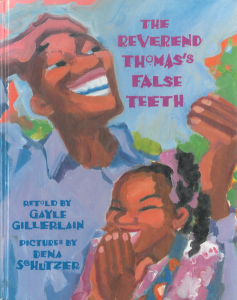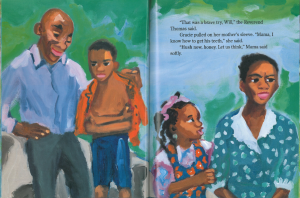Author: Gayle Gillerlain
Illustrator: Dena Schutzer
Publishing Information: BridgeWater Books, 1995.
Number of Pages: 30
Genre: Non-fiction, Picture book


Analysis:
Reverend Thomas was coming to Gracie’s home for dinner. Gracie and her family were so busy preparing the dishes for Reverend Thomas. However, he accidentally lost his false teeth overboard. Everyone tried to get the teeth for Reverend Thomas but they all failed. Finally, clever Gracie helped him find the teeth and they all enjoyed the delicious meal together.
This book includes spiritual and religious elements. The text serves as a window for children to look at one specific aspect of culture. Through the book, readers can have a glance at what the life of a Christian family is like. Therefore, readers can better connect the story with their own life.
I find this book problematic in various ways. Firstly, gender stereotypes and discriminations are presented. In the story, Gracie stayed at home and helped her mother prepare the dinner. We can see that her father was not doing anything because he is only mentioned by “Daddy rushed off with Will” (P. 8). Her brother was playing outside and not helping either. Besides, when people tried to think of methods to get Reverend Thomas’s teeth, nobody listened to Gracie. Secondly, when things happened accidentally, people pray. However, with all due respect, praying is not the way to actually solve the problem. After Reverend Thomas dropped his false teeth, the only thing he did was “praying for the safe return of his lost teeth” (P. 8). All of the neighbors helped him look for the teeth and Gracie’s brother Will even jumped into the water. It is not fair for everyone else to do the job for him even if he is honorable. Thirdly, when I read the method Gracie used to get the Reverend’s false teeth, I got a little confused. I think the author should elaborate it a little bit more about how Gracie used chicken for bait to catch the teeth.
Perceptually, the illustrations use bright colors to depict the joyful atmosphere. The pictures are not framed. Therefore, readers can have the view from within. Structurally, text and images overlap. Ideologically, the book teaches children to use their wisdom to solve problems instead of doing things without thinking.
